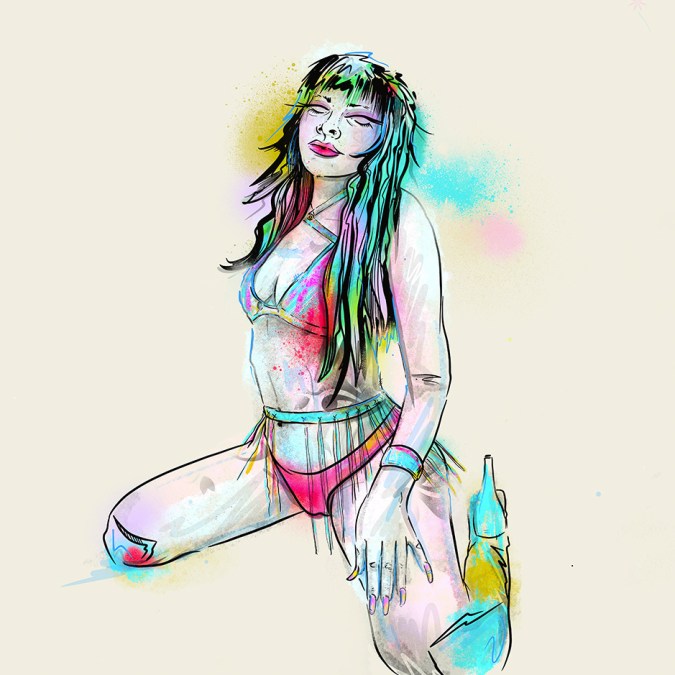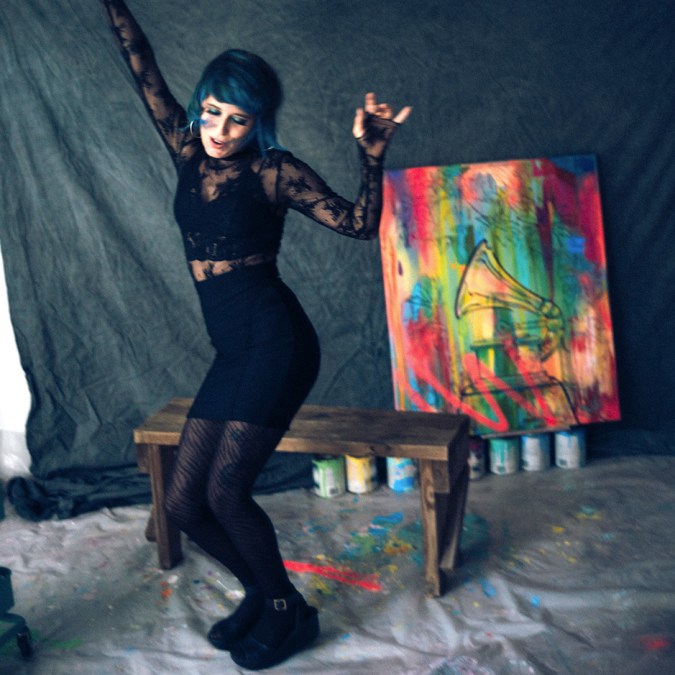When viewers tune into the 21st Annual Latin Grammy Awards on Thursday, they’ll spot the vibrantly-colored artwork of Sofía Maldonado-Suárez. The Latina creative was selected as the official artist of the award show, making her the first boricua to design their poster.
The Puerto Rico-born Maldonado-Suárez, who is of Cuban descent, designed the artwork that’s featured prominently on all of this year’s collateral materials. The timing, she says, couldn’t be more perfect: This year, the Latin Grammys will introduce new categories, including Best Reggaetón Performance and Best Rap/Hip-Hop Song, genres the Caribbean archipelago co-created and themes she explores in her art.
It’s brought reassurance to my visual dialogue.
“For me, one of the most exciting parts has been being able to represent Puerto Ricans,” Maldonado-Suárez tells Remezcla. She notes that the new categories, which have plenty of boricua nominees, could bring wins for Puerto Rico that its people—still recovering from hurricanes, earthquakes, the COVID-19 pandemic and political scandals—deserve. Here, we speak with Maldonado-Suárez about the exciting opportunity, her stunning design and her artistic work that explores womanhood, sexuality and trap music.
First, congratulations on being this year’s official artwork creator for the 21st Latin Grammys. That’s very exciting. This is also the first time the award show will include the categories of Best Reggaetón/Trap Song and Best Rap/Hip-Hop Song. Considering Puerto Ricans were co-creators of both hip-hop and reggaetón, how important do you think it is that the person creating artwork this year is boricua or has ties to these genres?
For me, it goes beyond that. Even though I’m boricua, a big part of my body of work since I started has always had a very organic connection with reggaetón, hip-hop and trap. I’ve always been inspired by hip-hop, especially Spanish-language hip-hop, and then later reggaetón. I’ve always been close to these genres, even when they were still underground. At the start of my artistic career, I always wanted to mix these passions of mine. I was used to going to reggaetón parties, to marquesinas, and dancing to the floor. I loved this and wanted to integrate it into my paintings. But it wasn’t until this year that it all clicked. I’ve been working with these themes for such a long time, and now look where it took me. It’s more than me being Latina, and it’s more than me being boricua. This project directly ties into the subjects I’ve been working on for so long, subjects I’ve always brought into my work. For example, in 2010, I had a mural that was protested in Times Square because it illustrated reggaetón dancers rather than so-called professional women. Ten years later, this aesthetic is being celebrated in a big way. It’s brought reassurance to my visual dialogue.

How did this opportunity come about?
It was one of those things that life just puts you in. I was approached through an email saying I was selected as the next artist to design the poster for the Latin Grammys. I was like, “what is this? Spam!” It came out of nowhere. I ended up having a conversation with the CEO of the Latin Grammys, and he was laughing so much because I was in shock. This took place in the middle of the shutdown, like early April. He told me that he had been looking up artist profiles, came across mine and others, but found himself continuing to come back to mine.
That’s amazing. As you said, your work has long explored gender, and womanhood in particular, within trap and hip-hop culture, including projects like Las Chicas de Sofia and the upcoming La Ninfaaa. Why? What do you think a woman’s lens brings to these topics?
From what I’ve seen from Cardi B, Megan Thee Stallion, Rosalía and a lot of women in music, and trap in particular, is women taking back their power. This, of course, isn’t new. But this generation is finally really resisting what we’ve been brainwashed to believe about our bodies, like they are temples that no one can see, and being empowered owners of our bodies. Through this, we are saying, ‘you can respect me even if I want to express my body in this way.’ We are seeing this a lot in trap culture.
This generation is finally really resisting what we’ve been brainwashed to believe about our bodies.
Historically, male rappers have always said what they were going to do to women’s bodies, and women didn’t even have a voice in the dialogue. Now they are responding, saying, ‘this is what I want you to do with my body, and I will show it off.’ But while we are having this great moment musically, artistically we are still seeing some censorship. I’ve been wanting to put this drawing up on social media, but it keeps being taken down because it’s a boob. Why do we live in a culture where the woman’s body is so censored? Who invented this? Where did it come from? Why do we play into this? This mentality can be broken by us when we take control.

You’ve worked on two projects that have merged the topics of womanhood and hip-hop: Las Chicas de Sofia and LaNinfaaa. Can you talk about these and how they are different from one another?
Las Chicas de Sofia is part of a longer and older project. When I was in high school, I would do graffiti and I always tagged a female character in trap. Everytime it was a different one. It was my way of showing my appreciation to these women and their flow. I was always painting, and I’d see them and love everything about them. I wanted to represent them, their expressions. But, again, I noticed that this work offended people. It was weird to me because people enjoyed watching these women in music videos but were offended by them when they were represented through street art.
La Ninfaaa is an upcoming project. During the pandemic, I started exploring my femininity and my sexuality. It was around this time that I discovered Demon Time, late-night Instagram Live streams from sex workers dancing. This eventually got banned, and then OnlyFans became a thing. I wanted to explore this fine line between pornorgraphy and being sexual. La Ninfaaa mixes trap, porn and mythology. It’s also different from my previous work because, in the past, I’ve also been the observer. But with La Ninfaaa, I’m putting myself in as a character. And it has led to a physical, emotional and mental transformation for me.
I know that during this pandemic even your artistic style has evolved, that you’ve been delving deeper into digital art and that you used some of these techniques in your design for the Latin Grammys poster.
Yes. So, in the past, what the Latin Grammys has done is commissioned artists to work on canvases. These canvases, which enter their collection, are photographed and used on promotional materials, like invitations. I told the Latin Grammys team that I had started working on digital formats and that I was enjoying it more and wanted to create a digital image as well as a canvas. I told them it would look nicer on their materials, and that it also tied into this whole digital era we are in because of the pandemic. They agreed, and I’m really excited about it.
This project, I hope, will open a lot of doors for a lot of women.
On that, what has been the most exciting part about working on this Latin Grammys project?
For me, one of the most exciting parts has been being able to represent Puerto Ricans. We’ve had such a difficult time, from Hurricane María, to the earthquakes and then to our political issues. My country needs good news, not more depressing news. We are amazing and deserve to be celebrated and recognized. I see how proud my people, my followers and my fans are that I got this opportunity to represent our country, our little island. And it’s not just that. If you see the nominations for these new categories, it’s a lot of Puerto Ricans. We’re No. 1 in Spanish trap and reggaetón, so we’re all just very excited. Personally, though, this pandemic has been really hard. At the beginning, all of my gigs closed down, but then out of the blue I got this amazing news. It’s all been very surreal. This project, I hope, will open a lot of doors for a lot of women.
Fingers crossed! In the meantime, where can people find your work?
Right now, my work is up on my Instagram and my website. My website also has some wearables from my Femtrap project. Additionally, I have two exhibitions right now in Puerto Rico. The first one is Las Chicas de Sofía: Una Mirada Introspectiva, which ties in different art works I’ve done from 2010 to 2017 about the women. You can really see the transition in my paintings to drawings. For me, it’s retrospective. That’s at the Sala de Exposiciones del Plata and ends on December 11. That same day, my La Ninfaaa exhibition will open, and this is where I explore female sensuality in a way that mixes trap culture and mythology, largely through my own personal experiences during the pandemic.




